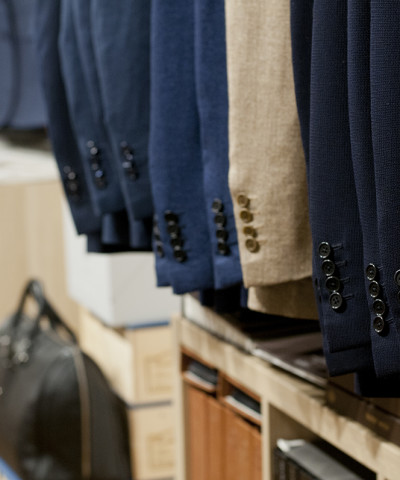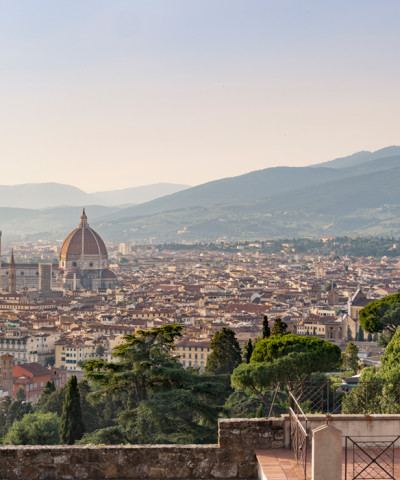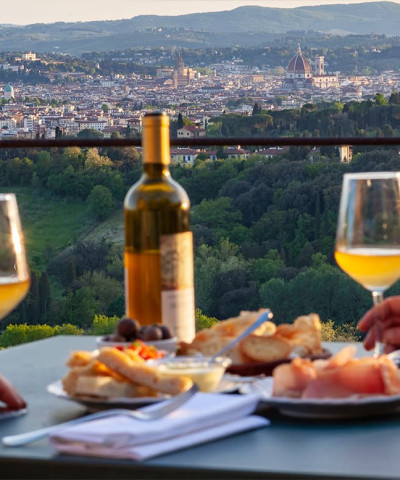photo cover Fondazione Bitossi © Delfino Sisto Legnani & Agnese Bedini / Archivio Fondazione V. Bitossi
Fai Days of Spring 2024: all the places open in Tuscany on March 23 and 24
Our mini-guide to choose which FAI visits to book province by province
Fai Days of Spring 2023 return on March 23 and 24 throughout Italy and allow free access to more than 750 places in 400 cities, most of them usually inaccessible or little known.
Many special places can also be visited in Tuscany, revealing an extraordinary wealth whose importance in terms of culture, history and traditions, sometimes hidden or unconventional, tells the identity of our country.
We remind you that to participate in the FAI Days, it is necessary to book (no later than midnight of the day before the visit) through the FAI website.
AREZZO
HISTORIC BUILDINGS AT THE SERVICE OF CITIZENS
The itinerary takes visitors to discover how much beauty lies behind the historic buildings that, as citizens, we visit every day in the routine performance of public services. It is this beauty, everyday and widespread, almost ignored and underestimated, that instead is the key to Italian uniqueness. In the itinerary, visitors can discover the history of 3 palaces that are now home to citizen services: Palazzo Pretorio, home of the City of Arezzo Municipal Library, Palazzo Albergotti building, dating back to the 1300s and home to the State Archives, and the imposing and representative Post Office Building.
CLOISTER OF SAN FRANCESCO (LUCIGNANO, AR)
The cloister today appears as an uninterrupted succession of cross vaults, set on side plumes (capitals with composite decoration) and stone columns equipped with a base and composite capital. One of the four sides turns out to be completely open, and corresponds to the side of access, through pietra serena walkway to the center of the cloister and to the cistern, while the remaining three sides show various architectural stratifications, we will see the Recovery and Re-functionalization of the Portico and Cloister of St. Francis in Lucignano wanted by the Municipal Administration in order to make it accessible and usable as a valuable historical asset.
 Lucignano
LucignanoFORTEZZA MEDICEA (LUCIGNANO, AR)
The recovery of the Fortezza Medicea, or rather of the Fortresses, as these imposing remains of 16th-century fortifications are commonly called, is being salvaged by the municipal administration after the property became part of its heritage. Having finally conquered Lucignano following the Battle of Scannagallo on August 2, 1554, Cosimo de' Medici thought it best to fortify even more this already well-guarded stronghold. He had the existing defensive structures consolidated and, above all, had a new fortress built on a hill a few hundred meters from the walls of the center, fearing some attempt at reconquest by the Sienese who were still operating in Valdichiana. We will see the restored part of the fortress. The turret is the one on which the administration intervened along with the royal gate and access routes, with the works included in the restoration project.
FLORENCE
PALAZZO BUONTALENTI (ANTICO CASINO MEDICEO DI SAN MARCO)
Palazzo Buontalenti is not accessible to the public, as it is the home of an international academic institution (School of Transnational Governance, EUI). The tour is divided within the restored area and allows visitors to admire above all the famous 17th-century fresco cycle executed in the north wing, commissioned in 1621 by Cardinal Carlo de' Medici. There are five rooms, each dedicated to one of the succeeding grand dukes of Tuscany until Cosimo II (Cosimo I, Francesco I, Ferdinando I and, indeed, Cosimo II, to whom an additional room was allocated). The frescoes are a compendium of the best Florentine artistic production of the early seventeenth century, executed with a wealth of references to the achievements of the four grand dukes in both the military and artistic-cultural spheres: the visit allows visitors to retrace the exploits and splendors of the Medici dynasty, while highlighting the differences in personality among the various members of the family who ascended to the grand ducal throne.
 PALAZZO BUONTALENTI © 2024 Marco Lodovichi
PALAZZO BUONTALENTI © 2024 Marco LodovichiPALAZZO MARUCELLI FENZI
Visitors are offered a tour itinerary from the monumental apartments on the ground floor, with the Hall of Hercules, the Hall of Youth at the Crossroads and the Hall of Punished Love, with sublime frescoes by Sebastiano Ricci and stuccoes by Giovanni Baratta, to the main floor via the monumental staircase to access the ballroom, now the Great Hall of the SAGAS Department. Although the palace and some of the rooms can be visited regularly upon request, some rooms are inaccessible to outside visitors as they are used as study and office spaces. The next edition of the FAI spring days is therefore the right opportunity to admire the beauty of these spaces and to learn about the history of a palace that is so important to Florentine history but still undiscovered.
SEAT OF THE RECTORATE OF THE UNIVERSITY OF FLORENCE
Places accessible, in general, only to University staff and students, as well as faculty from other universities, and open to the public only in exceptional cases, are made visitable. The tour itinerary starts from the entrance hall, from which one enters the porticoed arm overlooking the inner garden, enriched by the exhibition of Onofrio Pepe's works, set up on the occasion of the University's Centennial. Then walking along the grand staircase, at the end of which is the statue of Galileo (a copy of the statue made by A. Costoli for the Uffizi portico), one reaches the vestibule of the Great Hall. From the great hall, you proceed to the Academic Senate Hall. From here, one proceeds to visit the Board Room. It is thus also possible to understand the complexity of the site and learn about the history of the House of Wisdom, the Seraglio dei Leoni, the Teatro delle Cacce, and the Medici Stables, the latter studied by Leonardo da Vinci for their monumentality and functionality.
 Rettorato UniFI © 2024 Marco Lodovichi
Rettorato UniFI © 2024 Marco LodovichiARCHIVIO MUSEO FONDAZIONE VITTORIANO BITOSSI (MONTELUPO FIORENTINO, FI)
The Bitossi Museum Archives is open to the public by appointment Monday through Friday. Visits are accompanied by a historical-artistic narrative about the origins of the family and the territory, the evolution of the product from tradition to modernity, through the work of Aldo Londi and important collaborations with designers. The Business Archives as a representation of the company's identity, an instrument of knowledge is an inexhaustible source for new ideas and collections. The museum in its complexity becomes an engine of imagination, creates empathy and moves emotions through artistic, economic and social stories. The archive's activities are not limited to the strictly archival efforts of recovering, cataloging and preserving historical heritage, but it offers assistance and advice to scholars, students, researchers and collectors. It collaborates in cultural initiatives promoted by international public and private organizations and institutions.
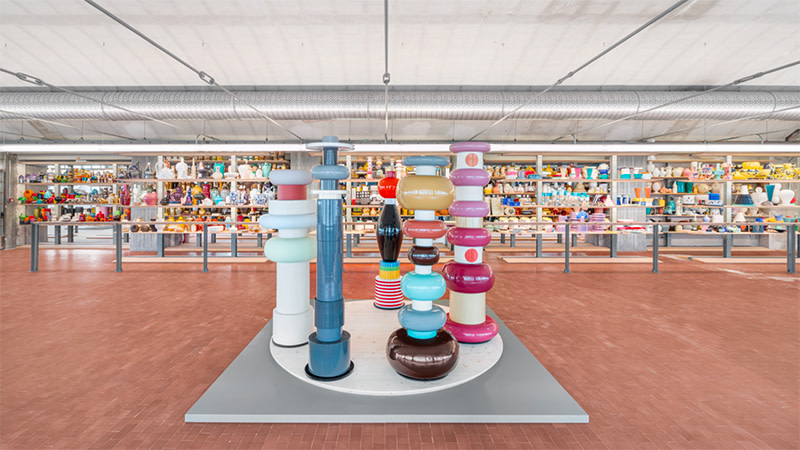 Fondazione Bitossi © Delfino Sisto Legnani & Agnese Bedini / Archivio Fondazione V. Bitossi
Fondazione Bitossi © Delfino Sisto Legnani & Agnese Bedini / Archivio Fondazione V. BitossiSPAZIO BRIZZOLARI (SCARPERIA E SAN PIERO, FI)
Rarely open site, unique experience. In contrast to the industrial area surrounding Spazio Brizzolari, the exceptional nature of the site is striking: a small New York corner nestled in the Mugello area. A path full of intense paintings, violent in their use of color, unfolds Antonio's thought, the ideology with which his production is permeated, his concept of vestitism that is, the transformation of his clothes into works of art. Gallery and Spazio Forma-Azione aim to expand the traditional concept of the museum, transforming it into a multifunctional environment capable of generating a disorientation and amazement that leads to the discovery of beauty in unexpected, unconventional contexts. "I want to amaze," stated Antonio Brizzolari himself, and this arouses Spazio Brizzolari!
 Spazio Brizzolari © 2024 Marco Lodovichi
Spazio Brizzolari © 2024 Marco LodovichiGROSSETO
GIARDINO DEI TAROCCHI AT GARAVICCHIO (CAPALBIO, GR)
Following the inspiration she had while visiting Antoni Gaudí's Parque Guell in Barcelona, Facteur Cheval's Ideal Palace in Hauterives, France, then reinforced by a visit to the garden of Bomarzo, Niki de Saint Phalle began the construction of her Garden in 1979: for more than seventeen years she devoted herself passionately to the creation of the twenty-two cyclopean statues, each representing one of the Major Arcana of the Tarot, covered with mosaics of mirrors, glass and ceramics, having several local workers, a team of famous names in contemporary art and, above all, her husband Jean Tinguely, who died in 1991 and was the author of the metal structures of the enormous sculptures (he integrated some of them with his mécaniques, self-propelled assemblages of mechanical iron elements). Access to the Garden is closed off by a long tufa wall, designed by Mario Botta, with a single large circular opening in the center: this dividing wall between the Garden and the outside world is thus intended as the threshold of access to a place of initiation, sharply divided from everyday reality and charged with symbolic complexity.
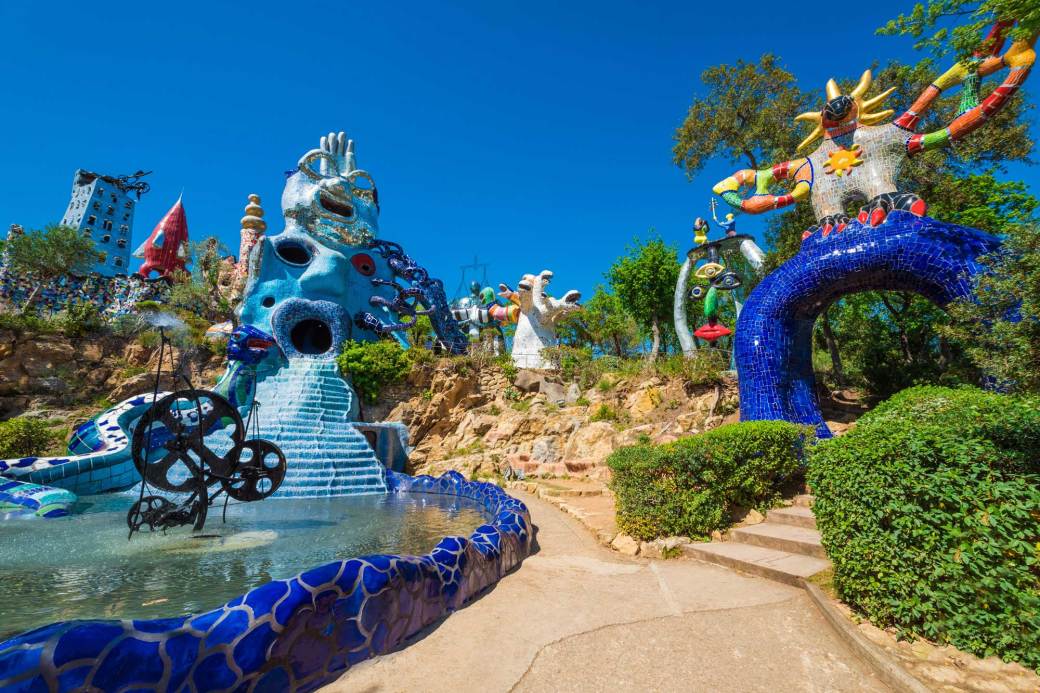 tarot garden
tarot gardenTHE VILLAGE OF CASTEL DEL PIANO (CASTEL DEL PIANO, GR)
The Celle will be the subject of our itinerary , the "Cella" system was the protagonist of the first sharecropping contract in 821, it was a mode of farm management abandoned only a few decades ago. Attention should definitely be drawn to the Cella di San Biagio which is located within the Gravilona Forest not far from the town of Castel del Piano, it is a place of surprising wealth. It should be noted that the 1571 "Statutes of the Community of Castel del Piano" stipulate that after paying the contributions due to the Republic of Siena, the economic benefits that the Forest of Gravilona grants to the village are to be used to "pay a schoolmaster to teach everyone's children to read and write." Also of special attention are the Cells of S.Maria del Noceto and Santa Lucia, the details of which will be revealed on site.
LIVORNO
PARK OF VILLA MAUROGORDATO
The itinerary inside Villa Maurogordato Park is a walk in an area recently rediscovered and enhanced thanks to the work of some city entities, such as Monterotondo Observatory Cultural Association, Provincia di Livorno, ANPANA OdV and Reset Odv, who have cleaned and brought to light some of the elements that characterized the 19th-century park attached to the Villa, such as the greenhouse or the pergola, which testify to the vitality, multiculturalism and centrality of Livorno as a port city and beyond until at least the beginning of the 20th century.
PARK OF VILLA RODOCANACCHI
The Rodoconacchi park and villa are located in the Monterotondo area, a hilly area about 7 km from the center of Livorno. An agricultural environment as early as 1200, the entire area was under the care of the Fathers of the Charterhouse of Calci, who entered into level contracts with local farmers. This use of the land remained agricultural until the 1700s, when the fashion for vacationing outside the city began.In Livorno, wealthy merchant families bought the land and appurtenances in the area and renovated the farmhouses, making them into stately homes. During the Dayit is possible to take a walk to discover the garden and all the elements that rise in it and are coming back to light, such as the artificial lake, the mill and the water regulation system.
 VILLA MAUROGORDATO
VILLA MAUROGORDATOSEDE AZIENDA KAYSER ITALIA
The building being visited is built in 1965 as the headquarters of the company BARCAS s.a.s. - Confezioni per signora, which makes, precisely, women's clothing that it sells in both the Italian and international markets (Libya, Egypt, France, etc.). With alternating fortunes and changes in corporate structure, the business continued until 1996, when it was put into liquidation. In the early 2000s, Kayser Italia took over ownership of the asset, renovated the building and set up its headquarters here. The company's business area (active since 1986) is in the design, production, testing and servicing of systems for aerospace research, satellite systems and subsystems, and defense avionics systems.The opening on FAI Days includes a guided tour inside the headquarters, discovering some of the deli environments where aerospace components are designed and manufactured that will participate in many European Space Agency (ESA) and Italian Space Agency (ASI) programs in the future. Normally not visitable as a workplace, during Spring Day Kayser Italia opens its doors to offer visitors a chance to learn about the activities of one of the flagship companies of both our city and the entire country. The tour is guided and groups accompanied by both Fai Volunteers and company staff, who will provide information and trivia.
LUCCA
CHIESA DI SANTA CATERINA
The history of St. Catherine's Church for 200 years has been intertwined with that of the Tobacco Factory opened July 7, 1815, a strong and important link. Workers before their shifts would stop by to pray, leaving Emilietta, the faithful janitor, the groceries to pick up at the end of work. Generations of female cigar workers did this until the church was closed because it was uninhabitable. This explains the link between the workplace and the church not only prayer but also a meeting between women of all ages social aspect that justifies the attachment still so alive today to this church by the citizenry Special event Sunday, March 24, 4:30 p.m., Concert by Maestro Guitarist Meme Lucarelli; limited seating for participation write to: segreteriafaitoscana@fondoambiente.it
 CHIESA DI SANTA CATERINA
CHIESA DI SANTA CATERINACABINET OF NATURAL HISTORY OF THE CLASSICAL HIGH SCHOOL N. MACHIAVELLI OF LUCCA
The opening on FAI days includes a guided tour of the Cabinet rooms, usually not open to the public except for study purposes, by the Apprentice Tour Guides. It is also possible to visit the Great Hall with its collection of physics instruments. This is an important opportunity for the general public, which, despite some exceptional annual openings organized by the Arcadia Scholastic Cooperative, is usually not familiar with this jewel of the city. The scientific cabinet dates back to 1857; inside in the showcases are preserved naturalistic remains, only of the furniture that contained them. In 1850 Grand Duke Leopold II donated the entire scientific collection to the Lucca Lyceum. The Museum's naturalistic collections were maintained and expanded until the first half of the 20th century. In 1870 from an inventory made by the Ministry of Education, there were 86 herpetological, 180 ichthyological, 92 mammalogical and 940 ornithological preparations and a buffalo skeleton in the zoological collections of the Cabinet of Natural History.
PIEVE DI SAN GIORGIO AT BRANCOLI
The parish church of San Giorgio in Brancoli is one of the most significant examples of the architectural language that matured between the 11th and 12th centuries. Typical of this orientation is the choice of large marble block wall faces framed at the ends by angular pilasters, and clearly defined volumes, as for the semi-cylindrical apse. Inside, the columns are topped by capitals with phytomorphic decorations in classical style; the stoup with protomes is signed by Raito. To a group of Lombard-Lucca workers, conventionally called Guidi, pertains the hexagonal baptismal font, the presbyterial enclosure and the ambo. Also of note are a 13th-century painted cross and a glazed terracotta depicting St. George. In addition to the tour that takes you on a discovery of the history of the Pieve di San Giorgio Brancoli, on Sunday, March 24 at 6 p.m. in the PIEVE there is a concert lasting 40/45 minutes including breaks to explain the chosen pieces and sequence to the audience. Usually open venue, accessible free of charge.
ARTE BARSANTI: STORIA DEI FIGURINAI E FIGURINE IN GESSO (BAGNI DI LUCCA, LU)
During FAI Spring Days for FAI members only, it will be possible to visit the craft workshop of the company "Arte Barsanti," where together with artisan Simone Fiori we will move to discover the traditional technique and materials of production, delving closely into all the fundamental steps. In addition, it will be possible to admire a repertoire of historical objects and documents that testify to the great diffusion that these creations have had and still have around the world.
EUROMARCHI: SULLE TRACCE DEI FIGURINAI DI BAGNI DI LUCCA (BAGNI DI LUCCA, LU)
During the FAI Spring Days, visitors will be taken on a discovery of the history and anecdotes of the traditional "mammalucchi," the name given in the local dialect to the crib figurines, through a visit to the factories of the company Euromarchi SRL. In particular, it will be possible to visit its exhibition hall, where the best examples of production from the past are collected, as well as a collection of documents and historical objects that tell the company's history and evolution.
MUSEO DI ARTE SACRA DI CAMAIORE (CAMAIORE, LU)
During the FAI days, it is possible to visit the museum's rooms, with its important collections of liturgical art, allowing one to discover a pearl unknown to most. The Virgin Annunciate by Matteo Civitali, restored to its splendor thanks to an incredible restoration work, stands out for its importance. Visitors will then undoubtedly be fascinated by the fine collection of sacred jewelry, and the 'impressive Flemish tapestry, the pride of the collection for its state of preservation and of which a theft was prevented in the 1930s. A visit to the museum, given its location in the center of Camaiore, also gives visitors the opportunity to tour the town, which saw its splendor in medieval times, and which at the time as still today is an important point of passage and departure for the Via Francigena route.
MASSA
MUSEO ETNOLOGICA DELLE APUANE LUIGI BONACOSCIA
The opening of the Apuan Ethnological Collection is extraordinary because it is normally closed and can only be visited by small groups of people by reservation. Visitors are guided inside numerous exhibition areas including a printing shop, a first aid station, an area of earthworking and olive growing, a cellar, a kitchen, and countless artifacts (including stoves, agricultural machinery, iron and woodworking, marble and plaster working, stone artifacts, industrial and agricultural equipment, vines and wine) to immerse themselves fully in one of the best-preserved cultural and anthropological testimonies of the last century in Tuscany.
RIFUGIO ANTIAEREO DELLA MARTANA
Retracing the cold, ghostly tunnels of the Martana Antiaircraft Shelter is a unique opportunity to understand the state of mind in which the population lived during the air raid alerts; the photographs and video interviews that are projected at the beginning of the visit recount the experience of the war from those who truly experienced it on their own skin; touching are the guide's accounts that bring you up to speed about the way the citizens of Massa flocked inside the shelter, their eyes full of terror, after being alerted by the frightening sound of the siren, at all hours of the day and night.
PISA
KINZICA, UBALDESCA E BONA, TRE DONNE IN SAN MARTINO
The neighborhood of Kinzica, south of the Arno River, the scene of the lives of the three women whose story we will tell, is included later than the northern area-in the circle of walls that since 1155 have borne witness to the urban development of Pisa. According to Maragone's chronicle, by 1161 only palisades had been raised in the Kinzica area, later replaced by more solid structures between the late 13th and mid-14th centuries. In Pisa, the Hierosolymitan settlement, church and hospital of St. Sepulchre, arose in Kinzica, outside the ancient civitas, between the river and today's Via San Martino. The statue of Kinzica is a reused Roman marble inserted into a building composed of two tower houses from the 13th century; the shelf on which it rests served to support the wooden parts. According to legend, Kinzica was a maiden who saved Pisa from the pirate Musetto.A walk through the neighborhood of Kinzica (about 300 meters) in the city center will be an opportunity to delve into the history of the city through the lives of three famous women in different capacities and linked to important monuments such as the churches of San Martino and Santo Sepolcro. The meeting will be in St. Martin's Square where the Apprentice Tour Guides will narrate a brief history of the neighborhood and the church, but especially the life of Bona buried here and point out other places in the city that preserve her memory. They will continue to No. 21 Via San Martino where the legend of Kinzica will be told and at the same time highlight the transformations from tower houses to palaces. Last stop will be the history of the church of San Sepolcro and how it ties in with the history of Ubaldesca.
BADIA DI SAN SAVINO
The Abbey of San Savino is a monastery-fortress, a fortified structure measuring 56 meters by 67.70; the battlements that once crowned it can still be distinguished, although they have been covered over to make dwellings and attics. It is arranged on two floors: on the ground floor the service rooms (storerooms, cellars stables), on the upper floor the monks' dwellings.The entrance to the monastery is of considerable interest: a wide doorway with a round arch leads to a steep staircase covered with a barrel vault and then a cross vault that ends in front of the church.This, in Romanesque style, is built with gray-white limestone blocks from Monte Pisano. On the exterior sides of the church are: an inscription relating to the founding of the 13th-century cloister, the funerary inscription of Abbot Guido, and the tombstone of Abbot Martino and Count Tancredi from the 12th century. The interior, in the shape of a Latin cross, holds a precious stoup made from an Etruscan cippus. At the end of the 16th century the church was heavily modified. In 1944 the bell tower was destroyed by retreating Germans and rebuilt in the 1990s in anastylosis. South of the church is the ancient cistern once surrounded by the cloister, replaced by a courtyard with grain pits(18th-19th).
 ABBAZIA S. SAVINO BADIA
ABBAZIA S. SAVINO BADIAPISTOIA
CHIESA DEI SANTI PROSPERO E FILIPPO NERI
Volunteers from the Fai Pistoia Montagna Pistoiese Group will open the doors of the Church of San Filippo and Prospero, whose history is rooted in the early Middle Ages. During the tour one is transported in the discovery of a building that still preserves its 18th-century image and the decorations of Baroque-era artists who marked the history of art in our region such as Giovan Domenico Ferretti. The church, a scenic example of Pistoiese Baroque, welcomes you to tell you about its evolution and its decorations, which conceal the taste and foresight of the Filippini Fathers who made it, together with the nearby Oratory, one of the places most frequented by the Pistoiese nobility in the 18th century.
PALAZZO DE' ROSSI
Volunteers from the Fai Pistoia Montagna Pistoiese Group accompany you to discover some of the rooms of Palazzo de' Rossi, a building that was born from an ancient Pistoiese legend and is a founding part of the history of the city's historic center. Overlooking the street of the same name, the palace has been home to the Caripit Foundation since 2000 and was restored between 2009 and 2013, bringing it back, after so many years, to its splendid 18th-century image with decorations made up to the 19th century. The Pistoia Group takes you to discover its history in a tour developed on 5 floors, starting from the myth of the Grandonio Warrior and the famous Black Heads to one of the most exclusive and exciting views of the city of Pistoia.
PALAZZO REALI VANNUCCI (PESCIA, PT)
The volunteers of the Fai Pistoia - Montagna Pistoiese Group will accompany you to discover some areas of Palazzo Reali Vannucci, a private palace in the heart of the historical center of the city. Overlooking via Abbi Pazienza, the Palace is a treasure trove, never before opened to the public, of art and architecture. The Group will lead you, with visits dedicated exclusively to FAI members, to discover the history of the families who built it, the history and place names of the urban fabric surrounding it, and the beauty it contains and connects to the other historic buildings adjacent to it.
ORATORIO DEL SS. ROSARIO (PESCIA, PT)
During the FAI Spring Days, this small gem, usually not open to visitors, is specially opened both on Saturday and Sunday for visitors who will be accompanied by FAI narrators as well as local guides who reveal the particular ritual of the "vescie" that was set up inside the Oratory during the Easter period. Not to forget how even the places furthest from the city and less known can reveal to the most curious and attentive visitors real treasures.
PIEVE DI CASTELVECCHIO (PESCIA, PT)
During the FAI Spring Days, this jewel of Romanesque architecture is open for visits both on Saturday and Sunday, accompanied by the storytelling of young student "apprentice guides" and local guides who will narrate the curiosities and legends of the area, which were called "canzone" (singular: canzona). Not forgetting how even the places furthest from the city and less known can reveal to the most curious and attentive visitors real treasures.
SAN QUIRICO: CHIESA E ORTO DEL PRETE (PESCIA, PT)
During the FAI Spring Days 2024, it will be possible to visit the Parish Church, the oratory where ancient sacred furnishings are preserved, some of remarkable craftsmanship, and the "priest's garden": a green space located at the height of the walkway of the walls and bastions of San Quirico, from which you can enjoy the splendid panorama of the Valleriana.
PRATO
IL FABBRICONE: LA FABBRICA E IL TEATRO
The properties are currently used for productive activities, largely carried out by the F.lli Balli woolen mill, and are therefore rarely open to the public, mainly for safety reasons. It is perhaps the most representative example of industrial archaeology in the city, both in terms of size and the type and quality of architectural components, as well as for its original characteristics of "complete cycle" processing. For the FAI Day occasion, rooms of particular value and importance, which are now rarely used, will be opened. We will enter the historic area by passing through the intermediate gate of the central avenue, which, not being manned, is exceptionally opened on this particular occasion, allowing you to enjoy the splendid visual telescope from via Bologna to the Bisenzio River.
SIENA
CHIESA DELLE CARCERI DI SANT'ANSANO
Saint Ansano, born around 284, possibly hailed from the gens Anicia, an ancient and noble Roman family, and was the son of Senator Tranquillino. It was his father who denounced him as a Christian, prompting Ansano to flee north, stopping first in Bagnoregio and then in Allerona, before finally arriving in Siena as directed by an angel. In Siena, he began to preach and baptize the first citizens, but he was imprisoned, according to tradition, in the tower next to the church of S. Ansano delle Carceri, continuing to baptize the Sienese from behind the bars of his cell. He underwent the ordeal of fire. Inside, on the main altar, there is a canvas by Francesco Rustici, known as Rustichino, depicting the Trial of Saint Ansano, signed and dated 1617. On the left wall, there are older frescoes attributed to the circle of Vecchietta or more likely to Priamo della Quercia, brother of the better-known Jacopo. They depict the Adoration of the Magi, the Crucifixion, and Saint Ansano. On the left of the entrance, there is a small chapel with a modern painting by Enzo Cesarini (1967), a Sienese painter with affinities to Mino Maccari. The painting depicts Saint Ansano baptizing the Sienese during his imprisonment.
CHIESA DI S. NICCOLÒ AL CARMINE
The most important work in the church is undoubtedly "St. Michael the Archangel Expelling the Rebellious Angels" by Domenico Beccafumi, dating from 1526-1535. Beneath the altar lie the relics of Blessed Franco Lippi da Grotti. According to Vasari, this work is considered the correct version, after the rejection by the Carmelites of the first version, now housed in the National Gallery of Siena. It was certainly already in the church in 1535 when Vasari saw it in the company of Baldassarre Peruzzi. The work originally had a predella, which was separated when the altar was refurbished in 1688. The compositional schemes of the work are very traditional and symmetrical, probably due to the previous rejection by the patrons of the first version of the painting. The main altar is a seventeenth-century artifact in polychrome marbles surmounted by a ciborium probably dating from the previous century. In the apsidal area of the church, there is a deep chapel behind the main altar, in which there are two emblems of the Wool Guild and several small sculptures that recall the school of the Mazzuoli family, active in Siena in the Baroque style of Bernini, up to the 18th century.
RISERVA NATURALE DI CORNOCCHIA (RADICONDOLI, SI)
At Cornocchia, you will see the Monterufoli ponies: used in the area since ancient times, these animals are intelligent, docile, and resilient, well-suited to rugged terrains. The Carabinieri for Biodiversity train the Monterufoli ponies for events such as the "saddle baptism" and demonstrative activities. The visiting itinerary includes the Villa, the chapel, and a nature walk in the forest rich in birdlife, covering about one kilometer.
 Radicondoli (SI)
Radicondoli (SI)









